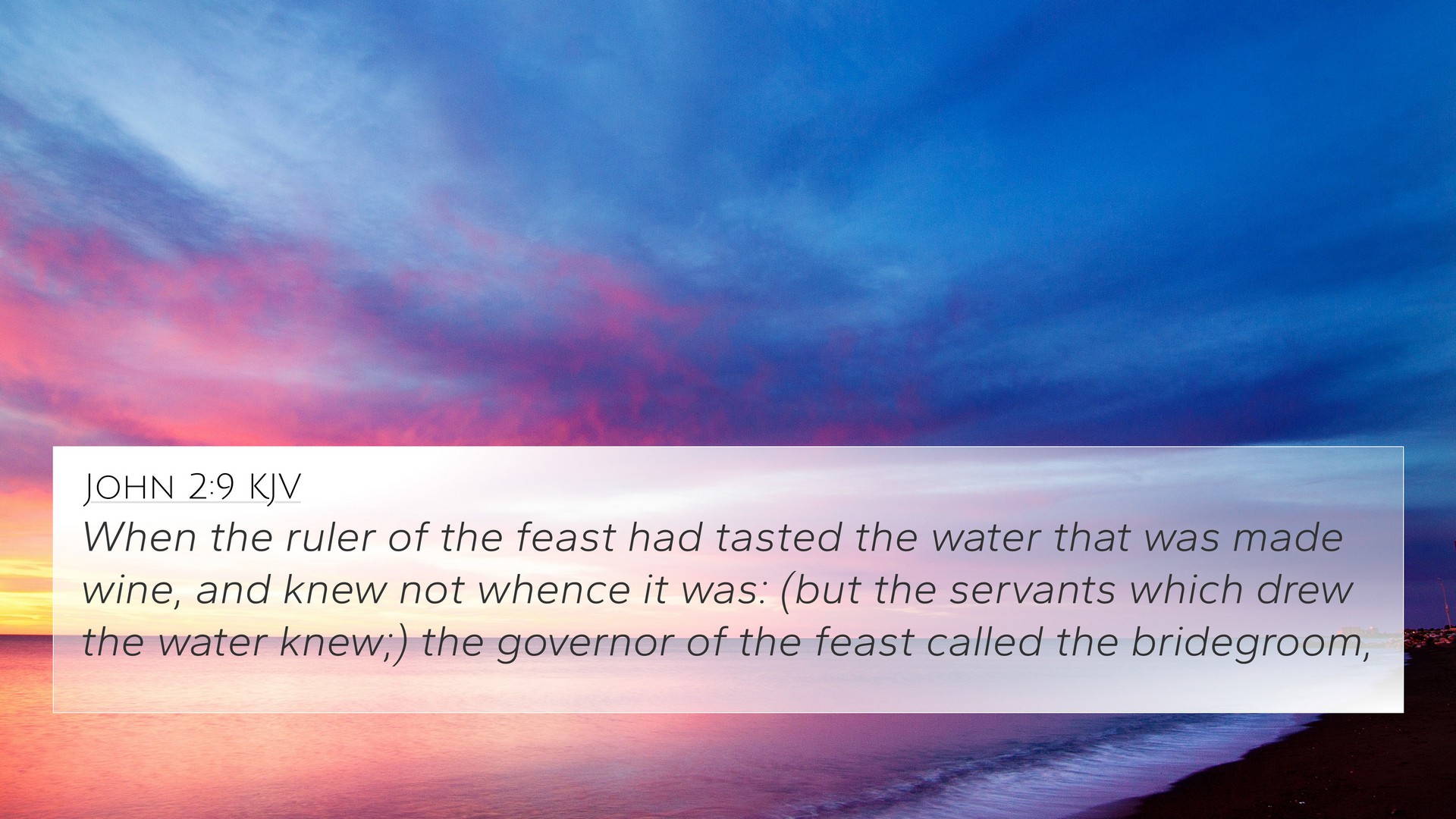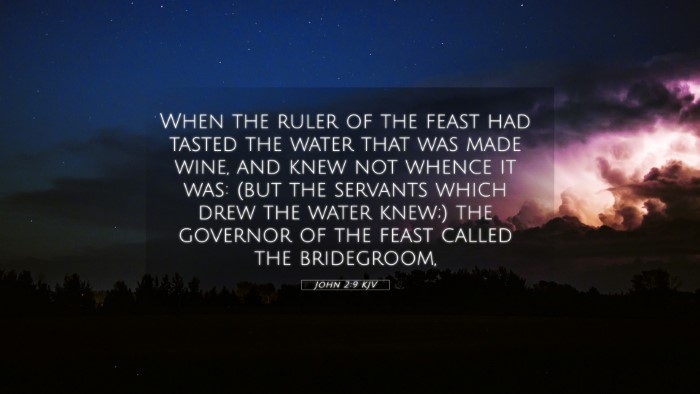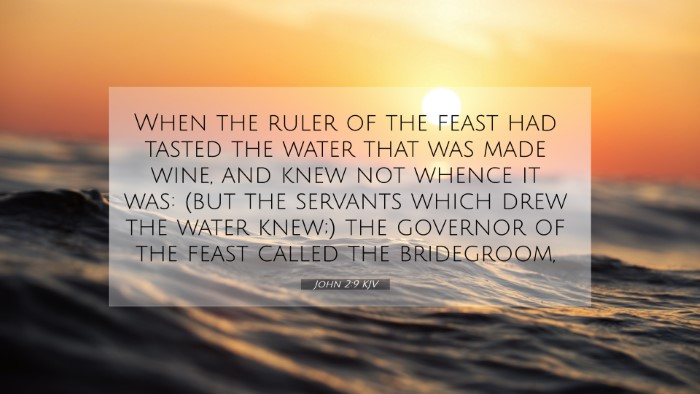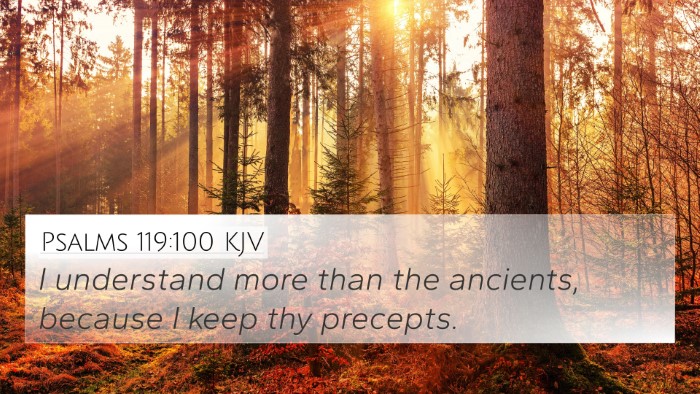Old Testament
Genesis Exodus Leviticus Numbers Deuteronomy Joshua Judges Ruth 1 Samuel 2 Samuel 1 Kings 2 Kings 1 Chronicles 2 Chronicles Ezra Nehemiah Esther Job Psalms Proverbs Ecclesiastes Song of Solomon Isaiah Jeremiah Lamentations Ezekiel Daniel Hosea Joel Amos Obadiah Jonah Micah Nahum Habakkuk Zephaniah Haggai Zechariah MalachiJohn 2:9 Similar Verses
John 2:9 Cross References
When the ruler of the feast had tasted the water that was made wine, and knew not whence it was: (but the servants which drew the water knew;) the governor of the feast called the bridegroom,
Uncover the Rich Themes and Topics of This Bible Verse
Listed below are the Bible themes associated with John 2:9. We invite you to explore each theme to gain deeper insights into the Scriptures.
John 2:9 Cross Reference Verses
This section features a detailed cross-reference designed to enrich your understanding of the Scriptures. Below, you will find carefully selected verses that echo the themes and teachings related to John 2:9 KJV. Click on any image to explore detailed analyses of related Bible verses and uncover deeper theological insights.
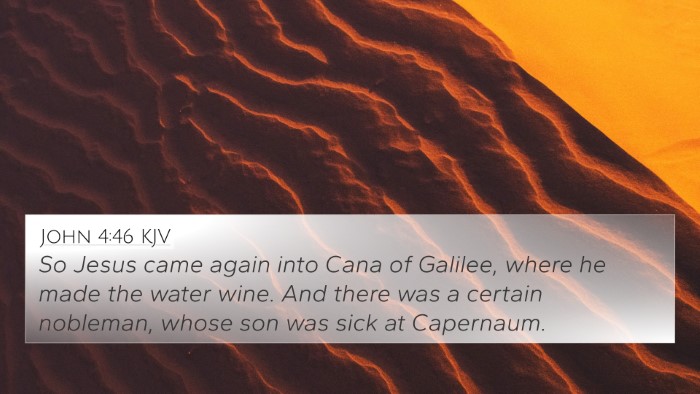
John 4:46 (KJV) »
So Jesus came again into Cana of Galilee, where he made the water wine. And there was a certain nobleman, whose son was sick at Capernaum.
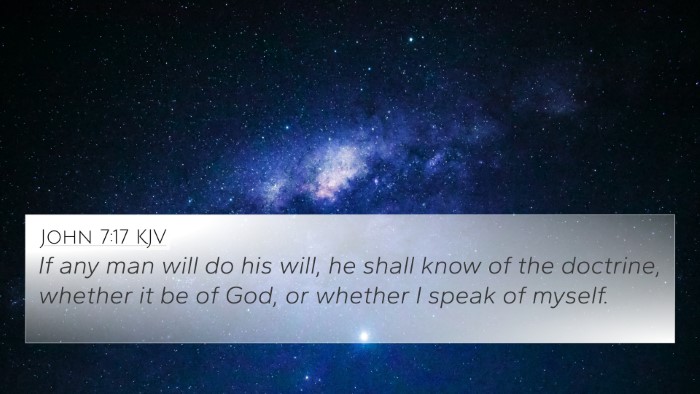
John 7:17 (KJV) »
If any man will do his will, he shall know of the doctrine, whether it be of God, or whether I speak of myself.
John 2:9 Verse Analysis and Similar Verses
Understanding John 2:9
Bible Verse: John 2:9 - "When the master of the feast had tasted the water that was made wine, and knew not whence it was: but the servants which drew the water knew: the master of the feast called the bridegroom."
Exploration of the Verse
In this passage, we witness a miraculous event at the wedding in Cana, where Jesus turns water into wine. This event is significant not only for its demonstration of Jesus' divine power but also for its implications regarding faith, recognition, and the transformative potential of Christ.
Insights from Public Domain Commentaries
-
Matthew Henry's Commentary:
Henry emphasizes that the miracle at the wedding in Cana highlighted Christ's glory and marks the beginning of His public ministry. The fact that the master of the feast was unaware of the transformation indicates the silent workings of a miraculous power that operates beyond human perception.
-
Albert Barnes' Notes:
Barnes explains the role of the servants who drew the water, suggesting that their knowledge of the miracle demonstrates a significant relationship with Jesus. This indicates that those who serve Him are privy to His works and the deeper meanings of His miracles.
-
Adam Clarke's Commentary:
Clarke adds that the wine produced is of extraordinary quality, typifying the spiritual abundance that Jesus brings into the lives of believers. It signifies a shift from the old covenant to a new one, where joy and celebration are hallmarks of genuine faith.
Key Themes in John 2:9
This verse encapsulates several important themes:
- Divine Intervention: The miracle signifies Jesus' authority over natural elements and serves as a sign of His divine identity.
- Faith and Awareness: The contrast between the master of the feast and the servants reflects differing levels of awareness regarding Jesus’ works.
- The Role of Servanthood: The servants who assisted in the miracle signify the importance of service in revealing divine truths.
- Transformation: The act of changing water into wine symbolizes spiritual transformation and the abundant life available through Christ.
Cross-References for Further Study
For a deeper understanding of John 2:9, one might explore the following Bible verses that connect thematically:
- Matthew 9:17: "Neither do men put new wine into old bottles: else the bottles break, and the wine runneth out, and the bottles perish: but they put new wine into new bottles, and both are preserved." (Transformation and renewal)
- Isaiah 25:6: "And in this mountain shall the Lord of hosts make unto all people a feast of fat things, a feast of wines on the lees, of fat things full of marrow, of wines on the lees well refined." (The promise of abundance)
- John 1:14: "And the Word was made flesh, and dwelt among us, (and we beheld his glory, the glory as of the only begotten of the Father,) full of grace and truth." (The manifestation of Christ's glory)
- John 3:30: "He must increase, but I must decrease." (Acknowledgment of Jesus' supremacy)
- Romans 14:17: "For the kingdom of God is not meat and drink; but righteousness, and peace, and joy in the Holy Ghost." (The inner joy of the spirit)
- Hebrews 8:6: "But now hath he obtained a more excellent ministry, by how much also he is the mediator of a better covenant, which was established upon better promises." (The new covenant)
- Luke 5:39: "No man also having drunk old wine straightway desireth new: for he saith, The old is better." (Resistance to change)
- Revelation 19:9: "And he saith unto me, Write, Blessed are they which are called unto the marriage supper of the Lamb." (The imagery of a wedding feast)
- Galatians 5:22-23: "But the fruit of the Spirit is love, joy, peace, longsuffering, gentleness, goodness, faith, Meekness, temperance: against such there is no law." (The fruit of transformation)
Applications and Reflections
As we analyze John 2:9 and its commentaries, several applications can be drawn for personal reflection:
- Consider the ways in which Christ transforms the ordinary aspects of life into extraordinary experiences.
- Reflect on your own awareness of God’s work in your life—are you like the master of the feast or the servants?
- Recognize the significance of servanthood in accessing the deeper revelations of God.
- Think about the joy that comes from spiritual abundance and how it contrasts with worldly offerings.
Conclusion
In John 2:9, we see a profound example of Jesus’ divinity manifested in a simple setting—a wedding. The miracle of turning water into wine is not merely an act of generosity but serves as a rich theological symbol of the new covenant, the joy of salvation, and the transformative power of Christ. Understanding this verse in light of cross-referencing with other scriptures allows for a deeper appreciation of its meaning and relevance within the Biblical narrative.
